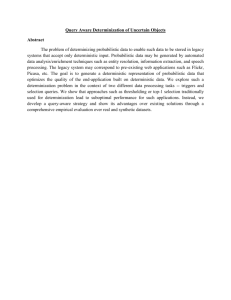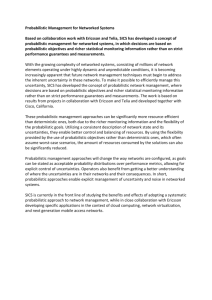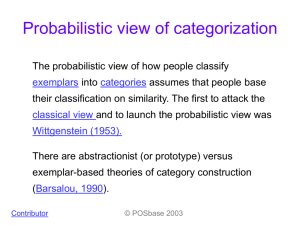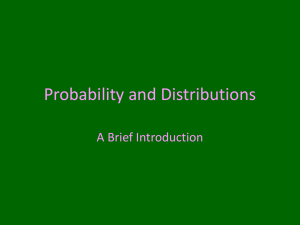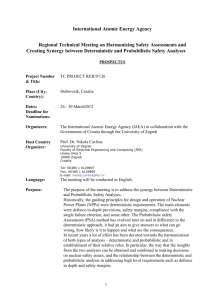Fun-with-Probability-Dr-Nic-2013
advertisement
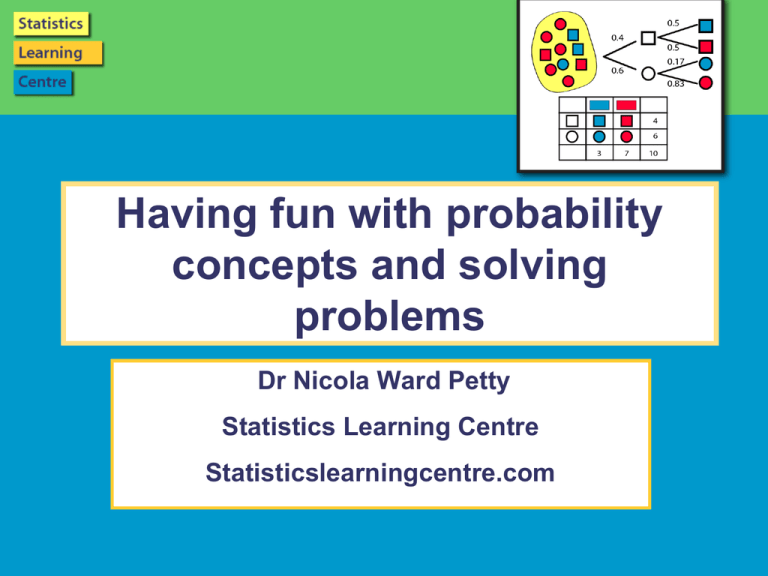
Page 1 Having fun with probability concepts and solving problems Dr Nicola Ward Petty Statistics Learning Centre Statisticslearningcentre.com Page 2 Statistics Learning Centre Based in Christchurch Started producing materials for NCEA Statistics in 2013 NZ Stats 3 and NZ Stats 2 – online resources to students Professional development for teachers Videos, blog, apps Consulting in Operations Research Inventors of Rogo Page 3 Introducing Dr Nic Dr Nicola Ward Petty BSc(Hons), DipTchg, PhD Lecturer in Operations Research at University of Canterbury for 20 years. Won UC teaching award, researched in education and statistics. Well-known blogger on teaching statistics. Popular YouTube videos Winner of Greenfield award for disseminating statistics PhD in operations research/ school effectiveness Loves to teach and to help teachers. Page 4 Move away from dice, coins, balls and urns! Not only are they boring but when we use equiprobable equipment all the time, it can entrench incorrect ideas. The problem with dice, coins, balls and urns Page 5 Not relevant ! Imply “true probability” – harder to get the idea of a model across when it seems true. Entrench equi-probability Ok to use a little, but be wary Cards have cultural issues – do not assume familiarity Page 6 Overview Water problem: True probability, model estimate, experimental estimate Curriculum progression Models - Scenario cards Ethics and probability Problems that matter On-line resources Page 7 Abstract (overly ambitious) We will attempt to cover the following questions and concepts: True probability? How are model estimates and experimental estimates related? What does the curriculum mean by good model, poor model and no model? How do you teach about deterministic and probabilistic models? What exactly is a model and why is it hard for students to get their heads around the concept? Finding and exploring problems that matter. Ethical aspects to the teaching of probability? On-line resources for teaching probability? Page 8 Probability is: Important Relevant Fun Applied Interesting Well contained Difficult – with literacy challenges Page 9 Water problem There has been an outbreak of a disease and authorities don’t know the source. It comes from the local drinking water. Can only test some people (why?) If I pick a person at random from this class, how likely is it that he or she has had a drink of tap water in the last 12 hours? How likely is it that a randomly chosen person will have had a drink of water? Page 10 Everyone write down your answer in words. Now write your answer using a number. Now all stand up and get in order. What do we (students/teachers) learn from this exercise? different terminology between people a way of assessing student understanding of the meaning of the numbers. Page 11 Quick Discussion How did you decide on your number? What kind of model is this? What information did you use? Do you think the people who did drink water would say a higher probability than those who didn’t? (Should they have?) Page 12 The distribution What other outcomes are possible? Didn’t drink water This is the full distribution – could have another discussion about timing, amount etc. Page 13 Discussion What type of probability model is this? - Subjective/ Objective - Are there any circumstances in which it could be called a good model? - Why do we call it a model? Page 14 Improving our probability estimate How can we get a better idea of the probability of a water drinker? Take a sample: Ten people – what have you got? Drank Didn’t drink Number Probability Would you change your model? Page 15 Discussion What kind of model is that? Probability based on model or experiment? No model/ poor model/ good model? Purpose How can we make it better? Bigger sample. From the curriculum (Senior secondary guide) Page 16 Probability distributions can be investigated by making assumptions about the situation and applying probability rules and/or by doing repeated trials of the situation and collecting frequencies. Interprets results of probability investigations, demonstrating understanding of the relationship between true probability (unknown and unique to the situation), model estimates (theoretical probability), and experimental estimates. Page 17 True probability If we ask the whole group and get the correct proportions, will that give us the true probability? No. We never know the true probability. It is always only a model. But this is a VERY good model. Teaching hint – also use an example for which the true probability is difficult to model – eg Lego brick. (Senior Secondary Guide has a lesson extending to random variables) Page 18 Testing it Who has a surname starting with P? Did you have a drink of water? What does that tell us about our estimate? Unless our probability for drinking water was 0 or 1, a single result doesn’t tell us anything! Page 19 Relationships between models True probability Model estimate of probability Unknown Experimental estimate of probability Includes theoretical distributions, often based on experimental data. Affected by sample size Why does this matter? Dr Nic’s take on it Page 20 Probabilistic thinking is difficult but important. Misconceptions abound. Traditional approaches over-emphasise the predictive ability. Two ways of approaching (frequentist, “exact”) can be kept too separate in students’ minds. By emphasising the concept of the “model” we can teach the idea of probability as a useful construct, rather than “the truth”. Curriculum progression – Primary levels Page 21 From Key Ideas on NZMaths site Level 1 – chance situations, always, sometimes, never Level 2 – comparative – more or less likely Level 3 – quantifying – theoretical and experimental – distributions, models Level 4 – Two stage probabilities, comparing experimental results, idea of independence Curriculum progression – Secondary Page 22 Level 5 – (Years 9 and 10) Two and three stage probabilities, comparing experimental results, theoretical models. “Students need to recognise that theoretical model probabilities and experimental estimates of probabilities are approximations of the true probabilities which are never known.” Level 6 – NCEA Level 1- as above, plus discrete random variables, role of sample size Level 7 – NCEA Level 2 - Continuous random variables, normal distribution, tree diagrams, tables, simulations, technology. Continue to emphasise good, no and poor model. Level 8 - NCEA Level 3 – Distributions, randomness, types of model, simulation Page 23 Extending the water example Only three tests available – probability all same result. Probability of getting disease is 0.95 if drank, 0.1 if didn’t drink. Make up table from this. Good problem because: Interesting Detective-like – has a real application Not personal Page 24 Question How long will it take me to get from here to Hamilton? What do we take into account? Deterministic Probabilistic What will the answer look like? This is a model! Page 25 Models Mathematical modelling used in Operations Research, engineering, medicine, biology… Also a way of thinking, communicating Always an approximation of the real-life situation or problem Has a purpose Profit = Revenue - Costs Scenario exercise – probabilistic and deterministic thinking Page 26 You have some cards with scenarios printed on them. Work with the other people with the same coloured cards as you. Put the cards in order – the criteria are up to you. (Or sort into different categories) Page 27 Scenarios A.The All Blacks won the Rugby World Cup. B.We jumped in the swimming pool and got wet. C.Eri did better on a test after getting tuition. D.Holly was diagnosed with cancer, had a religious experience and the cancer was gone. E.A pet was given a homeopathic remedy and got better. F. Bill won $20 million in Lotto. G.You got five out of five right in a true/false quiz. H.Your friend cheated in class and got caught. Page 28 Discuss As students What criteria? Likely, important, predictable, cause and effect For each scenario give a deterministic and a probabilistic explanation As teachers What can this exercise teach? Ethical aspects? Would it work? How might it help towards understanding uncertainty and probability? Page 29 Ethics and probability People’s understanding of probability and chance events has an impact on how they see the world as well as the decisions they make. Challenge thinking, but be gentle, not arrogant. Sensitive to personal experiences, cancer, road accidents, religion, earthquakes. Think about your stance on gambling. http://learnandteachstatistics.wordpress.com/201 3/05/27/probability-and-deity/ Page 30 Problems that matter Use real data (e.g. crime reporting and resolution, emergency calls, pocket money, environmental issues, safety…) Things that matter to students: Fairness in chance events – ballot for tickets, privileges, partner in assignment, talent shows Gameshows, especially Deal or No Deal (See blog) Crime investigations, forensics and proof Computer and board games MP3 shuffle Sport Lego Minifigures or New World toys Page 31 Cool ideas Random dance, music, art work Page 32 On-line resources Manipulatives Nrich Videos, background Understanding uncertainty NOT Khan academy – too mechanistic, flawed Teaching suggestions Senior Secondary Guides (Lego example) Census @ School Page 34 References Pfannkuch, M., & Ziedins, I. (in press). A modeling perspective on probability. In E. Chernoff & B. Sriraman (Eds.), Probabilistic thinking: Presenting plural perspectives. Springer. Page 35 statsLC.com


